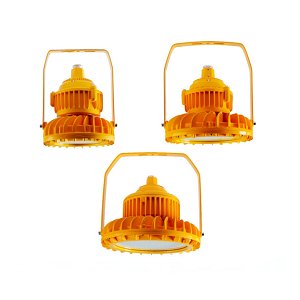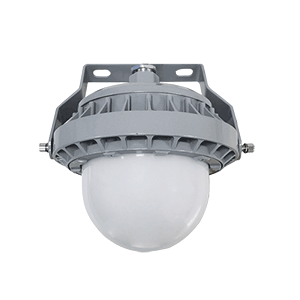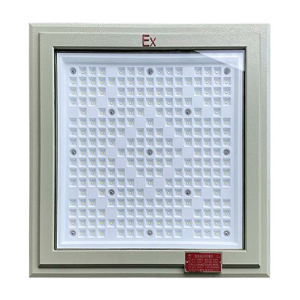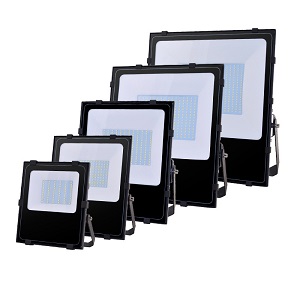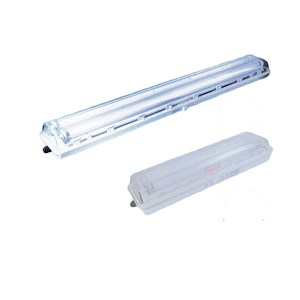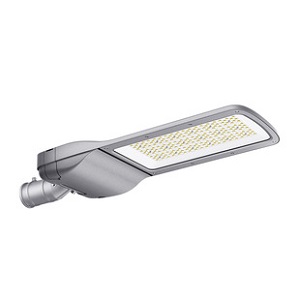Factory plant explosion proof lamps with the use and maintenance of guidance
According to the relevant information, caused by electrical equipment, 60% of the explosion caused by lighting caused by the accident, which is caused by portable lamps and lanterns in more than 80% of the accident. It seems that the use of explosion-proof lamps and lanterns in factories has a significant impact on the safe operation of petrochemical production facilities. According to the engineering design, construction and ordinary use, maintenance of explosion-proof lighting experience, the use of explosion-proof lighting and maintenance of several key points for a simple explanation.
1. explosion-proof lights and lanterns classification
explosion-proof lamps and lanterns are generally classified according to the choice of light source, explosion-proof structure type, use. Classification of explosion-proof incandescent lamps, explosion-proof high-pressure mercury lamps, explosion-proof low-pressure fluorescent lamps, mixed light source lamps, etc.; classification of explosion-proof structural type explosion-proof lamps and lanterns, safety-enhancing lamps and lanterns, composite lamps and lanterns, etc.; classified according to the way of use of fixed explosion-proof lamps and lanterns and portable explosion-proof lamps and lanterns.
2. Explosion-proof lamps and lanterns selection
Explosion-proof lamps and lanterns selection of light sources. Although there are still more incandescent lamps to dump but due to low luminous efficiency, shorter life, is gradually being replaced by other light sources. One of the more widely used is a single plug without starter fluorescent lamps and self-ballasted high-pressure mercury lamps and high-pressure sodium lamps.
2.1 Explosion-proof fluorescent lamp
single-plug fluorescent lamp without starter is a kind of cold cathode gas discharge lamp, the light-emitting principle is the use of electrodes between the discharge of mercury atoms to produce ultraviolet radiation, which excites the fluorescent material inside the tube to emit light.
This fluorescent lamp luminous efficiency is high (about 3 times that of incandescent lamps), long service life, starting without a starter (usually in the wall of the lamp there is a conductive layer, known as the glow layer, fluorescent lamps rely on it to complete the glow; when the lamp rupture the glow layer is also destroyed, the lamp that is extinguished), the cathode temperature is low (about 200 ℃ or so), it is a safe and practical light source, is very suitable for making the safety-boosting type Lighting fixtures.
2.2 Explosion-proof high-pressure mercury lamp
Self-ballasted high-pressure mercury lamp is the use of high-pressure mercury vapor discharge, as well as incandescent and fluorescent three kinds of material light-emitting hybrid light source lamp. It has the advantages of high brightness, simple structure, fast starting speed.
Changed the previous high-pressure mercury lamps need to add the shortcomings of the ballast, the use of tungsten filament to play a role in limiting the current, but also to improve the light color. The disadvantage is that the life expectancy is shorter than that of ordinary fluorescent high-pressure mercury lamps. High-pressure sodium lamp is a high-pressure sodium vapor discharge lamp, with high luminous efficiency, low power consumption, fog permeability, long life and other advantages.
The author’s unit production unit is now mainly used in single-plug fluorescent lamps without starter and self-ballasted high-pressure mercury lamps. The original fixed explosion-proof incandescent lamps, in order to meet the regulations of the minimum distance between the bulb and the transparent cover, recognized by the relevant units, are the use of the original lamps and lanterns with self-ballasted high-pressure mercury bulbs to replace incandescent bulbs.
2.3 explosion-proof high-pressure sodium lamp
high-pressure sodium lamps have a certain energy-saving effect, but because of its poor color rendering, we generally do not use in the production unit, only used in road lighting. Sometimes in order to improve the high-pressure mercury lamp issued by the straight white light color, can also be mixed with some high-pressure sodium lamps in the production unit. For the need for good color rendering of high-intensity lighting places (such as large units of equipment for on-site maintenance), you can choose explosion-proof floodlights, the light source is generally used with metal halide lamps, rated power can reach more than 1000W.
Explosion-proof lamps and lanterns selection points
Explosion-proof structure of the explosion-proof lights and lanterns type, according to the explosive gas environment of the regional level and scope of the decision, such as the scope of the 1 area must be used in explosion-proof lamps and lanterns; 2 area of the fixed lamps and lanterns can be used to isolate the explosion and increase the safety of the type of mobile lamps and lanterns must be used in explosion-proof type.
Selected explosion-proof lamps and lanterns level or group, should not be lower than the explosion hazardous environment of the explosive mixture level and group. At the same time to consider the impact of the environment on the explosion-proof lamps and lanterns, should meet the ambient temperature, air humidity, corrosive or contaminating substances and other requirements of different environments.
According to different environmental requirements to choose the level of protection of lamps and lanterns and corrosion levels. Especially in the presence of corrosive gases in explosive gas environments, the choice of lamps and lanterns with the appropriate anti-corrosion properties is essential.
Previously, the lighting fixtures for explosion hazardous places in petrochemical enterprises mainly used flameproof type. With the widespread use of safety-enhanced electrical equipment in Zone 2 explosion hazardous locations, safety-enhanced and composite lighting fixtures are also increasingly being used. Increase the safety of the lamps and lanterns in a certain explosion-proof performance on the basis of the same as the explosion-proof lamps and lanterns, compared with light weight, low price, easy to install and maintain, long service life and other advantages.
In the petrochemical industry is the most common use of composite electrical equipment is to increase the safety of an explosion-proof composite explosion-proof electrical equipment, generally by the explosion-proof components, increase the safety of the type of terminals and increase the safety of the shell of the three parts, which has both explosion-proof safety performance, but also has the advantages of the type of increased safety.
3. Explosion-proof lamps and lanterns maintenance and overhaul
Explosion-proof lights and lanterns in the installation before the nameplate and product specifications to check: explosion-proof type, category, level, group; shell protection level; installation and installation of fasteners required. Explosion-proof lamps and lanterns should be installed to ensure that the fixed firmly, fastening bolts shall not be arbitrarily replaced, spring washers should be complete.
Dustproof, waterproof seals should be placed as is when installed. Cable inlet, cable and sealing washer to be a close fit, the cable section should be round, and the surface of the sheath should not be uneven and other defects. The excess cable inlet shall be sealed according to the explosion-proof type, and the compression nut shall be tightened to make the inlet sealed.
In the daily repair and maintenance, need to pay attention to the following points.
(1) explosion-proof lamps and lanterns should be able to automatically cut off the power supply before opening. But because of the complexity of setting up interlocking devices, it is not easy to realize, so most of the lamps and lanterns only in the shell of the obvious place to set up “forbidden to open with electricity” and other words of the warning sign.
And because the surface temperature of the bulb after the power failure is still very high, such as immediately open the lampshade, there is still a risk of ignition of explosive gas mixtures (mainly refers to the structure of the explosion-proof), so incandescent, high-pressure mercury lamps, high-pressure sodium lamps, these bulbs have a high surface temperature of the light, but also quickly open the cover of the lamps and lanterns to pay attention to this point. I use more units of explosion-proof fluorescent lamps with open cover power interlocking mechanism for the maintenance work provides a convenient and safe. Because fluorescent lamps for cold light source lamps and lanterns, there is no surface high temperature, power can be opened immediately after the cover.
(2) in the replacement of light bulbs (tubes), explosion-proof lamps and lanterns explosion-proof joint surface should be properly protected from damage; after cleaning the explosion-proof surface should be coated with phosphating paste or 204-1 rust preventive oil, is strictly prohibited to paint other paints; explosion-proof surface shall not have a layer of corrosion, such as the more minor corrosion, should not be cleaned by the phenomenon of saprophyllous.
Used for dustproof, waterproof with the sealing ring must ensure that intact, this is very important for the increased safety lamps and lanterns. If the sealing ring is seriously damaged, with the same specifications, the same material sealing ring to be replaced, if necessary, replace the entire lamp. Inspection and maintenance should pay attention to whether the lampshade is intact, such as rupture should be replaced immediately.
(3) portable lamps and lanterns are divided into two kinds of power supply from the grid and bring their own power supply. Grid-powered lamps and lanterns, from explosion-proof junction box (box) or explosion-proof plug to the lamps and lanterns should be used between the rubber cable, the ground or zero core should be in the same jacket; cable should be used for the main core of the minimum allowable cross-section of 25 (mm ²) of the YC, YCW heavy-duty rubber cable. Here to emphasize one point in particular: portable lamps and lanterns of the cable does not allow intermediate joints.
A unit has occurred in such an accident: a night repair of ethylene transfer pumps, connected to the temporary explosion-proof lamps two, explosion-proof marking for IIC T4. When the clampman picked up the lamps close to the pump body to look at, ignited from the pump body leakage of ethylene gas will be one of the facial burns. After checking the explosion-proof performance of the lamps and lanterns is normal, the problem is in the lamps and lanterns on the cable.
Originally, 1.5m from the lamps and lanterns, there is a cable connector, wrapped in insulating cloth, leading lamps and lanterns cable trailing on the ground, exposing the cable core, when the clampman lifted the lamps and lanterns irradiation pump body, the exposed core touched the equipment base groove on the steel, and then to the ground to the fire, the ignition of the ethylene gas mixture.
This accident exposed the loopholes in explosion-proof safety management. After the accident, all portable lamps and their cables were carefully inspected, eliminating the potential for similar accidents.
This accident shows that in the electrical explosion-proof safety management, there must not be a fluke, in strict accordance with the relevant regulations and requirements to do, in order to do everything.


